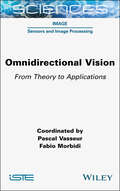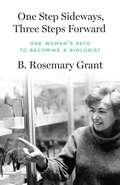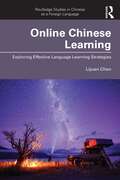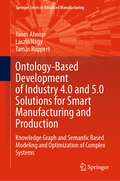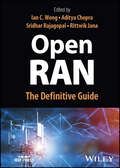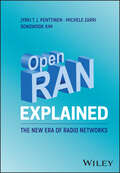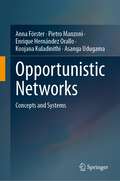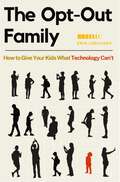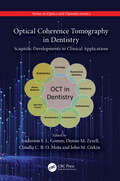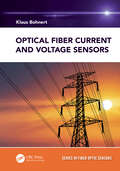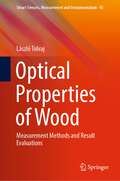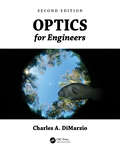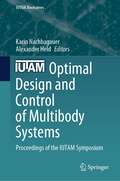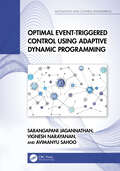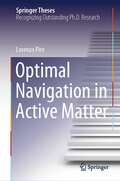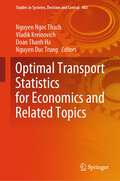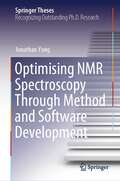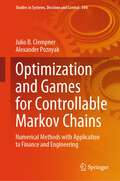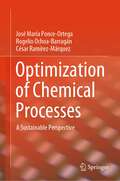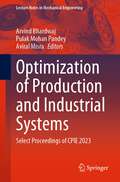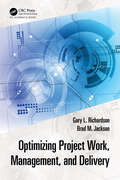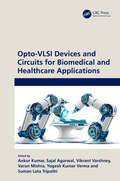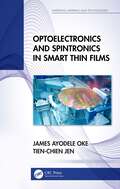- Table View
- List View
Omnidirectional Vision: From Theory to Applications
by Pascal Vasseur Fabio MorbidiOmnidirectional cameras, vision sensors that can capture 360° images, have in recent years had growing success in computer vision, robotics and the entertainment industry. In fact, modern omnidirectional cameras are compact, lightweight and inexpensive, and are thus being integrated in an increasing number of robotic platforms and consumer devices. However, the special format of output data requires tools that are appropriate for camera calibration, signal analysis and image interpretation. This book is divided into six chapters written by world-renowned scholars. In a rigorous yet accessible way, the mathematical foundation of omnidirectional vision is presented, from image geometry and camera calibration to image processing for central and non-central panoramic systems. Special emphasis is given to fisheye cameras and catadioptric systems, which combine mirrors with lenses. The main applications of omnidirectional vision, including 3D scene reconstruction and robot localization and navigation, are also surveyed. Finally, the recent trend towards AI-infused methods (deep learning architectures) and other emerging research directions are discussed.
One Perfect Stranger: An utterly gripping psychological thriller with a heart-stopping twist
by R.B. Egan'Full of twists and turns that keeps you constantly guessing... a gripping read' Reader review 'Has it all - pace, action, intrigue, mystery, dark secrets, relatable characters and an intricately woven plot. I devoured it in one weekend... Fantastic' Andrea Mara'Page-turner of a thriller I would recommend to everyone. I enjoyed the fast pace... I was unable to guess who was behind everything until the reveal' Reader review Would you commit a crime to save your family? Nicole had the perfect life, with her handsome surgeon husband Mark, their two young daughters and a beautiful big house. But everything changed when Mark suddenly left his job at the hospital six months ago. He's distant. Keeping secrets. And they are out of money. Then Nicole gets a strange message: There is a million euros in your bank account. All you need to do is drive a car. Yes, or no? This would be the answer to her prayers. It would save her family. But who sent it? What do they really want from Nicole? And why hasn't Mark come home? An absolutely addictive and gripping thriller with twists and turns you just won't see coming. Fans of Lisa Jewell, TM Logan and CL Taylor will be hooked from the very first page. Everyone is gripped by One Perfect Stranger: 'A tense, taut, pacy read' Jane Corry 'Gripping story right to the very end... An unsettling feeling that this could, just maybe, so easily happen to someone like you' Reader review 'An intense and twisting mystery that surprised me at every turn. Thrilling stuff!' C.M. Ewan 'Superbly plotted... Gripping and sinister. Towards the end, I had a "freeze response" holding my breath anxiously. I was foxed all the way through to its blistering, unexpected ending. What would I have done in Nicole's position?' Reader review 'A suburban nightmare of secrets, lies and labyrinthine twists' Catherine Kirwan
One Perfect Stranger: An utterly gripping psychological thriller with a heart-stopping twist
by R.B. Egan'Full of twists and turns that keeps you constantly guessing... a gripping read' Reader review'Has it all - pace, action, intrigue, mystery, dark secrets, relatable characters and an intricately woven plot. I devoured it in one weekend... Fantastic' Andrea Mara'Page-turner of a thriller I would recommend to everyone. I enjoyed the fast pace... I was unable to guess who was behind everything until the reveal' Reader reviewWould you commit a crime to save your family?Nicole had the perfect life, with her handsome surgeon husband Mark, their two young daughters and a beautiful big house.But everything changed when Mark suddenly left his job at the hospital six months ago. He's distant. Keeping secrets. And they are out of money.Then Nicole gets a strange message:There is a million euros in your bank account. All you need to do is drive a car. Yes, or no?This would be the answer to her prayers. It would save her family. But who sent it? What do they really want from Nicole?And why hasn't Mark come home?An absolutely addictive and gripping thriller with twists and turns you just won't see coming. Fans of Lisa Jewell, TM Logan and CL Taylor will be hooked from the very first page. Everyone is gripped by One Perfect Stranger:'A tense, taut, pacy read' Jane Corry 'Gripping story right to the very end... An unsettling feeling that this could, just maybe, so easily happen to someone like you' Reader review'An intense and twisting mystery that surprised me at every turn. Thrilling stuff!' C.M. Ewan 'Superbly plotted... Gripping and sinister. Towards the end, I had a "freeze response" holding my breath anxiously. I was foxed all the way through to its blistering, unexpected ending. What would I have done in Nicole's position?' Reader review'A suburban nightmare of secrets, lies and labyrinthine twists' Catherine Kirwan
One Step Sideways, Three Steps Forward: One Woman’s Path to Becoming a Biologist
by B. Rosemary GrantThe story of the unorthodox and inspiring life and career of a pioneering biologist Scientist Rosemary Grant&’s journey in life has involved detours and sidesteps—not the shortest or the straightest of paths, but one that has led her to the top of evolutionary biology. In this engaging and moving book, Grant tells the story of her life and career—from her childhood love of nature in England&’s Lake District to an undergraduate education at the University of Edinburgh through a swerve to Canada and teaching, followed by marriage, children, a PhD at age forty-nine, and her life&’s work with Darwin&’s finches in the Galápagos islands. Grant&’s unorthodox career is one woman&’s solution to the problem of combining professional life as a field biologist with raising a family.Grant describes her youthful interest in fossils, which inspired her to imagine another world, distant yet connected in time—and which anticipated her later work in evolutionary biology. She and her husband, Peter Grant, visited the Galápagos archipelago annually for forty years, tracking the fates of the finches on the small, uninhabited island of Daphne Major. Their work has profoundly altered our understanding of how a group of eighteen species has diversified from a single ancestral species, demonstrating that evolution by natural selection can be observed and interpreted in an entirely natural environment. Grant&’s story shows the rewards of following a winding path and the joy of working closely with a partner, sharing ideas, disappointments, and successes.
Online Chinese Learning: Exploring Effective Language Learning Strategies (Routledge Studies in Chinese as a Foreign Language)
by Lijuan ChenOnline Chinese Learning aims to investigate the types of language learning strategies (LLSs) that online Chinese learners use across asynchronous and synchronous learning environments in different learning contexts.This book examines how the use of language learning strategies by online Chinese learners is influenced by the interactants; the characteristics of the specific learning context; and selected individual learner characteristics. This book will provide: (1) new and detailed information about students’ LLS use in online Chinese learning; (2) insights into how individual students adopt LLSs and technological tools to solve learning problems in various learning contexts; (3) an exploration of factors influencing LLS use; and (4) recommendations regarding LLS adoption, use, and training.This book will be a valuable resource for university instructors in languages, language teaching methods, and second language acquisition, as well as researchers in languages, linguistics, and language learning and teaching.
Ontology-Based Development of Industry 4.0 and 5.0 Solutions for Smart Manufacturing and Production: Knowledge Graph and Semantic Based Modeling and Optimization of Complex Systems (Springer Series in Advanced Manufacturing)
by János Abonyi László Nagy Tamás RuppertThis book presents a comprehensive framework for developing Industry 4.0 and 5.0 solutions through the use of ontology modeling and graph-based optimization techniques. With effective information management being critical to successful manufacturing processes, this book emphasizes the importance of adequate modeling and systematic analysis of interacting elements in the era of smart manufacturing. The book provides an extensive overview of semantic technologies and their potential to integrate with existing industrial standards, planning, and execution systems to provide efficient data processing and analysis. It also investigates the design of Industry 5.0 solutions and the need for problem-specific descriptions of production processes, operator skills and states, and sensor monitoring in intelligent spaces. The book proposes that ontology-based data can efficiently represent enterprise and manufacturing datasets. The book is divided into two parts: modeling and optimization. The semantic modeling part provides an overview of ontologies and knowledge graphs that can be used to create Industry 4.0 and 5.0 applications, with two detailed applications presented on a reproducible industrial case study. The optimization part of the book focuses on network science-based process optimization and presents various detailed applications, such as graph-based analytics, assembly line balancing, and community detection. The book is based on six key points: the need for horizontal and vertical integration in modern industry; the potential benefits of integrating semantic technologies into ERP and MES systems; the importance of optimization methods in Industry 4.0 and 5.0 concepts; the need to process large amounts of data while ensuring interoperability and re-usability factors; the potential for digital twin models to model smart factories, including big data access; and the need to integrate human factors in CPSs and provide adequate methods to facilitate collaboration and support shop floor workers.
Open RAN: The Definitive Guide
by Ian C. Wong Aditya Chopra Sridhar Rajagopal Rittwik JanaOpen RAN A comprehensive survey of Open RAN technology and its ecosystem In Open RAN: The Definitive Guide, a team of distinguished industry leaders deliver an authoritative guide to all four principles of the Open RAN vision: openness, virtualization, intelligence, and interoperability. Written by the industry experts currently defining the specifications, building the systems, and testing and deploying the networks, the book covers O-RAN architecture, the fronthaul interface, security, cloudification, virtualization, intelligence, certification, badging, and standardization. This critical reference on Open RAN explains how and why an open and disaggregated, intelligent, and fully virtualized network is the way networks should be designed and deployed moving forward. Readers will also find: A thorough introduction from key industry players, including AT&T, Telefonica, Mavenir, VMWare, Google and VIAVI Comprehensive explorations of Open X-Haul transport networks and other unique 5G capabilities Practical discussions of the four pillars of O-RAN architecture: openness, virtualization, intelligence, and interoperability Comprehensive treatments of how smaller vendors can introduce their own services and customize the network Perfect for engineers, product managers, and marketing professionals in the telecom industry, Open RAN: The Definitive Guide will also benefit graduate students, researchers, and engineers in government agencies with involvement in the wireless and telecom industries.
Open RAN Explained: The New Era of Radio Networks
by Jyrki T. Penttinen Michele Zarri Dongwook KimOpen RAN EXPLAINED A pioneering outline of the concepts that enhance 5G capabilities to revolutionize the telecommunications industry. Open radio-access network, or Open RAN, is a type of network architecture in which baseband and radio unit components from different suppliers can operate seamlessly in concert. Advances in network communication were, until recently, hampered by the proprietary network operations of each mobile operator; the advent of 5G, however, with its service-based architecture model, has finally opened the door to the expansion of connectivity on the Open RAN model. This transformation promises to define the future of mobile network architecture. Open RAN Explained is among the first books dedicated to this groundbreaking technology. Its comprehensive but accessible summary of current and future developments in Open RAN promises to facilitate network deployment and device design, as well as to provide a handy reference for network professionals in a range of different fields. The result is a must-read volume for anyone looking to understand the future of wireless communication. Open RAN Explained readers will also find: In-depth description of the challenges and opportunities of network modularizationAnalysis conversant with the latest release specifications of the O-RAN Allliance, GSMA OP/TIP, and other key emerging technologiesAuthors working at the leading edge of 5G network communications Open RAN Explained is ideal for network operators, network element and device manufacturers, telecommunications researchers, and advanced students, as well as industry-adjacent figures such as regulators, consultants, and marketing professionals.
Opportunistic Networks: Concepts and Systems
by Anna Förster Pietro Manzoni Enrique Hernández Orallo Koojana Kuladinithi Asanga UdugamaThis textbook provides an exhaustive exploration of Opportunistic Networks (OppNets). Divided into three parts, it starts with the foundational principles and metrics of OppNets, detailing their mobility and data dissemination. Significant focus is given to the security challenges faced by OppNets, including strategies to counter various attacks. The second part evaluates OppNets, introducing methods and metrics for assessment, theoretical and simulation models, and tools such as OMNeT++, The ONE and ns-3.This textbook also offers comparative analyses and discussions on benchmarking. The third part delves into the implementation of OppNets, discussing technologies from Mobile Ad Hoc Networks to satellite communication and their integration with cellular technologies like 4G, 5G and 6G. Detailed insight into device characterization reveals the potential and limitations of devices within OppNets. Practical applications of OppNets in scenarios such as disaster management, remotecommunication, IoT challenges, smart cities and satellite networks are presented as well. Through detailed discussions and case studies, readers gain a comprehensive understanding of the structure, operation and practical implications of OppNets. It equips readers with knowledge to appreciate the vast potential of OppNets in various applications and settings.This textbook targets advanced-level students and postdocs in computer science and electrical engineering as well as researchers, who are starting new in the area and need a comprehensive view of opportunistic networks. Practitioners who are interested in applying the concepts of opportunistic networks in their products and services, and would like to have a jump start into the development and applications of opportunistic networks will also want to purchase this book as a reference.
The Opt-Out Family: How to Give Your Kids What Technology Can't
by Erin LoechnerDiscover a new and hopeful path forward as you consider your family's approach to social media, screen time, and technology.We've all heard the mind-boggling statistics about technology and social media use. The numbers don't lie; our obsession with smartphones and social media is slowly eroding the very essence of our homes and families. We see it. We feel it. We know it.So what do we do about it?Spoiler alert: Forget parental control apps, time limits, or reward charts. This revolutionary path takes us into the heart of the beast itself: the social media algorithm. Former social media influencer and trailblazer Erin Loechner has seen the perks and pitfalls of social media usage, and she knows how to hack the strategies of tech wizards and platform experts so you can borrow their billion-dollar playbook to engage your family in meaningful ways away from screens.The Opt-Out Family is packed with eye-opening research and startling insights, as well as practical encouragement and creative ideas to transform your family's relationship with today's ever-evolving technology. As a result, you will:Experience more quality time with your children that doesn't revolve around screensCreate healthy habits as a family that will set your children up for success in the futureDiscover what your kids actually need from you, and learn how to delight and engage them better than a device canAnd, ultimately, establish true and lasting influence within your own four walls--and far beyondThe Opt-Out Family unlocks a world where genuine connections flourish and technology takes a backseat. It's time to reclaim your home and build a tech-free family culture that's stronger than your Wi-Fi signal.
Optical Coherence Tomography in Dentistry: Scientific Developments to Clinical Applications (Series in Optics and Optoelectronics)
by Gomes, Anderson S. L.Optical Coherence Tomography (OCT), a method to "see inside of things" without destroying them, has been applied to subjects ranging from materials science to medicine. This book focuses on the biomedical application of OCT in dentistry, covering topics from dental materials to clinical practice. Since the introduction of the OCT method in ophthalmology in 1991, and then dentistry in 1998, developments in OCT methods, particularly in biomedical areas, have led to its dissemination worldwide. The chapters of this book cover the basics and recent global advances of OCT in dentistry, including an overview of the method and its use in cariology, restorative dentistry, dental materials, endodontics, pediatric dentistry, orthodontics, prosthodontics, soft oral tissues and nanodentistry. This book will be of interest to both newcomers in the field as well as those already working in OCT, either in research and/or the clinic. It will be of great use in courses on optical imaging applied to biomedical areas, particularly where it can provide real-life examples of the application of OCT.
Optical Fiber Current and Voltage Sensors (Series in Fiber Optic Sensors)
by Klaus BohnertOptical Fiber Current and Voltage Sensors is the first book to provide a complete, comprehensive and up to date treatment of the domain of fiber optic and polarimetric sensors, covering fundamental operating principles, characteristics, and construction. Written by one of the most recognised experts in polarimetric sensing, Optical Fiber Current and Voltage Sensors begins by covering the fundamentals of polarized light, as well as essential sensor components. The author then goes on to outline various sensor types and their applications, with a focus on sensors for electric phenomena. The chapters then lay out the demands that sensors need to meet, the technical obstacles and limitations which need to be considered. The book also covers comparisons to corresponding traditional instruments, as well as covering alternative non-conventional sensors. This book will be of interest to a broad audience of prospective readers ranging from graduate research students, to researchers in physics and engineering fields, to industry professionals active in the field who wish to learn about the technology and/or are interested in the development of new commercial solutions based on polarimetric-type fiber sensing as well as their use for high voltage current and voltage sensing.
Optical Properties of Wood: Measurement Methods and Result Evaluations (Smart Sensors, Measurement and Instrumentation #45)
by László TolvajThis book describes all optical properties of wooden materials, including definitions and measurement methods of optical parameters such as absorbance, diffuse and specular reflectance, colour and gloss. Basic knowledge regarding the reflectance measurement in the ultraviolet, visible, near- and middle infrared radiation ranges is also discussed. It examines conducting correct optical measurements, as well as introduces the validity limits of the individual methods. Steaming as an environmental-friendly colour modification process is introduced by the description of the steaming properties of eight species. Steaming schedules for wood-working industry are suggested to create optimum colour modification. Natural and artificial aspects of photodegradation are monitored by studying the colour change and using infrared reflectance spectrum measurement. The effect of influencing parameters such as temperature, relative air humidity and leaching effect of rain is also discussed. Combined effects of heat and light on the optical properties of wood in all possible combinations are presented. The book helps wood researchers and Ph.D. students perform correct and repeatable optical measurements and evaluations in order to draw the right conclusions.
Optics for Engineers
by Charles A. DiMarzioThis textbook provides an accessible introduction to the fundamentals of geometric and physical optics as they relate to practical problems encountered by engineers and researchers in designing and analyzing optical systems.In this updated edition, the author focuses on topics that are critical to understanding how the basic principles of optics affect design decisions. In addition to information on breadboarding experiments and prototypes, the new edition also expands its coverage of diffraction and includes numerous complete examples, and practical remindersProfessor Charles A. DiMarzio is an associate professor in the Department of Electrical and Computer Engineering, the Department of Mechanical and Industrial Engineering, and the Department of Bioengineering at Northeastern University in Boston, Massachusetts. He spent 14 years at Raytheon Company’s Electro-Optics Systems Laboratory in coherent laser radar for air safety and meteorology. Among other projects there, he worked on an airborne laser radar, flown on the Galileo-II, to monitor airflow related to severe storms, pollution, and wind energy, and another laser radar to characterize the wake vortices of landing aircraft. His current research in biomedical optics focuses on microscopy including coherent imaging, structured illumination, and multi-modal imaging. He is also a founding member of Gordon-CenSSIS – the Gordon Center for Subsurface Sensing and Imaging Systems.
Optimal Design and Control of Multibody Systems: Proceedings of the IUTAM Symposium (IUTAM Bookseries #42)
by Karin Nachbagauer Alexander HeldThis book presents the proceedings of the IUTAM Symposium on Optimal Design and Control of Multibody Systems 2022, covering research papers in the realm of optimal structural and control design for both rigid and flexible multibody systems. It delves into the application of the adjoint approach, enabling the undertaking of extensive topology optimizations to unearth body designs that excel under time- and design-dependent loads. Encompassing presentations on (adjoint) sensitivity analysis, structural optimization, optimal control, robust optimization, artificial intelligence, machine learning, and computational methods and software development, the IUTAM Symposium 2022 showcased the latest breakthroughs and innovative methodologies. This book presents 14 meticulously peer-reviewed proceedings papers from the event, evenly split between the Optimal Design and Optimal Control panels.
Optimal Event-Triggered Control Using Adaptive Dynamic Programming (ISSN)
by Sarangapani Jagannathan Vignesh Narayanan Avimanyu SahooOptimal Event-triggered Control using Adaptive Dynamic Programming discusses event triggered controller design which includes optimal control and event sampling design for linear and nonlinear dynamic systems including networked control systems (NCS) when the system dynamics are both known and uncertain. The NCS are a first step to realize cyber-physical systems (CPS) or industry 4.0 vision. The authors apply several powerful modern control techniques to the design of event-triggered controllers and derive event-trigger condition and demonstrate closed-loop stability. Detailed derivations, rigorous stability proofs, computer simulation examples, and downloadable MATLAB® codes are included for each case.The book begins by providing background on linear and nonlinear systems, NCS, networked imperfections, distributed systems, adaptive dynamic programming and optimal control, stability theory, and optimal adaptive event-triggered controller design in continuous-time and discrete-time for linear, nonlinear and distributed systems. It lays the foundation for reinforcement learning-based optimal adaptive controller use for infinite horizons. The text then: Introduces event triggered control of linear and nonlinear systems, describing the design of adaptive controllers for them Presents neural network-based optimal adaptive control and game theoretic formulation of linear and nonlinear systems enclosed by a communication network Addresses the stochastic optimal control of linear and nonlinear NCS by using neuro dynamic programming Explores optimal adaptive design for nonlinear two-player zero-sum games under communication constraints to solve optimal policy and event trigger condition Treats an event-sampled distributed linear and nonlinear systems to minimize transmission of state and control signals within the feedback loop via the communication network Covers several examples along the way and provides applications of event triggered control of robot manipulators, UAV and distributed joint optimal network scheduling and control design for wireless NCS/CPS in order to realize industry 4.0 vision An ideal textbook for senior undergraduate students, graduate students, university researchers, and practicing engineers, Optimal Event Triggered Control Design using Adaptive Dynamic Programming instills a solid understanding of neural network-based optimal controllers under event-sampling and how to build them so as to attain CPS or Industry 4.0 vision.
Optimal Navigation in Active Matter (Springer Theses)
by Lorenzo PiroEfficient navigation in terms of travel time and energy dissipation is of crucial importance for biological micro-swimmers. The design of optimally navigating artificial swimmers also has potentially valuable applications such as targeted drug delivery, which has become an increasingly realistic perspective due to the recent progress in the experimental realization of controllable microswimmers able to perform nontrivial tasks. Despite recent theoretical progress, the field still faces open challenges, notably in describing navigation problems that take into account the complexities of the world of microswimmers.This book presents a selection of works on the problem of optimal microswimmer navigation that represent a significant advance in this direction. The material in this book provides important insights into how efficient navigation may be achieved in the presence of curved space geometry, confining forces and flows, as well as thermal fluctuations. Finally, the energetic cost of navigation is addressed via a new formulation of the problem that accounts for the swimmer body geometry.
Optimal Transport Statistics for Economics and Related Topics (Studies in Systems, Decision and Control #483)
by Nguyen Ngoc Thach Vladik Kreinovich Doan Thanh Ha Nguyen Duc TrungThis volume emphasizes techniques of optimal transport statistics, but it also describes and uses other econometric techniques, ranging from more traditional statistical techniques to more innovative ones such as quantiles (in particular, multidimensional quantiles), maximum entropy approach, and machine learning. Applications range from general analysis of GDP growth, stock market, and consumer prices to analysis of specific sectors of economics (construction, credit and banking, energy, health, labor, textile, tourism, international trade) to specific issues affecting economy such as bankruptcy, effect of Covid-19 pandemic, effect of pollution, effect of gender, cryptocurrencies, and the existence of shadow economy. Papers presented in this volume also cover data processing techniques, with economic and financial application being the unifying theme. This volume shows what has been achieved, but even more important are remaining open problems. We hope that this volume will: inspire practitioners to learn how to apply state-of-the-art techniques, especially techniques of optimal transport statistics, to economic and financial problems, and inspire researchers to further improve the existing techniques and to come up with new techniques for studying economic and financial phenomena.
Optimising NMR Spectroscopy Through Method and Software Development (Springer Theses)
by Jonathan YongThis book provides a comprehensive overview of Nuclear Magnetic Resonance (NMR) theory, its applications, and advanced techniques to improve the quality and speed of NMR data acquisition. In this book, the author expands his outstanding Ph.D. thesis and provides a valuable resource for researchers, professionals, and students in the field of NMR spectroscopy. The book covers quantum mechanics basics, and topics like density operators, pulse sequences, 1D pulse acquisition, INEPT (Insensitive nuclei enhancement by polarization transfer), product operators, and 2D NMR principles. It also explores innovative experiments like States HSQC (Heteronuclear Single Quantum Coherence) and echo-antiecho HSQC with gradients. In the subsequent chapters, the author discusses Pure Shift NMR, including PSYCHE (Pure Shift Yielded by Chirp Excitation) and its optimizations, such as waveform parameterization and time-reversal methods. The 'Discrete PSYCHE' approach and Ultrafast PSYCHE-iDOSY (Diffusion-ordered spectroscopy) are also highlighted. This book presents the POISE (Parameter Optimisation by Iterative Spectral Evaluation) software for real-time NMR experiment optimization, including pulse width calibration and Ernst angle optimization, and demonstrates applications across various NMR experiments. Lastly, the book examines accelerated 2D NMR data collection and the NOAH (NMR by Ordered Acquisition using 1H detection) supersequences, emphasizing automated pulse program creation using GENESIS (GENEration of Supersequences In Silico). Covered NMR experiments include 13C sensitivity-enhanced HSQC, 15N HMQC (Heteronuclear Multiple Quantum Coherence), dual HSQC, HSQC-TOCSY (Total Correlation Spectroscopy), HMBC (Heteronuclear Multiple Bond Correlation), and ADEQUATE (Adequate Sensitivity Double-Quantum Spectroscopy).
Optimization and Games for Controllable Markov Chains: Numerical Methods with Application to Finance and Engineering (Studies in Systems, Decision and Control #504)
by Julio B. Clempner Alexander PoznyakThis book considers a class of ergodic finite controllable Markov's chains. The main idea behind the method, described in this book, is to develop the original discrete optimization problems (or game models) in the space of randomized formulations, where the variables stand in for the distributions (mixed strategies or preferences) of the original discrete (pure) strategies in the use. The following suppositions are made: a finite state space, a limited action space, continuity of the probabilities and rewards associated with the actions, and a necessity for accessibility. These hypotheses lead to the existence of an optimal policy. The best course of action is always stationary. It is either simple (i.e., nonrandomized stationary) or composed of two nonrandomized policies, which is equivalent to randomly selecting one of two simple policies throughout each epoch by tossing a biased coin. As a bonus, the optimization procedure just has to repeatedly solve the time-average dynamic programming equation, making it theoretically feasible to choose the optimum course of action under the global restriction. In the ergodic cases the state distributions, generated by the corresponding transition equations, exponentially quickly converge to their stationary (final) values. This makes it possible to employ all widely used optimization methods (such as Gradient-like procedures, Extra-proximal method, Lagrange's multipliers, Tikhonov's regularization), including the related numerical techniques. In the book we tackle different problems and theoretical Markov models like controllable and ergodic Markov chains, multi-objective Pareto front solutions, partially observable Markov chains, continuous-time Markov chains, Nash equilibrium and Stackelberg equilibrium, Lyapunov-like function in Markov chains, Best-reply strategy, Bayesian incentive-compatible mechanisms, Bayesian Partially Observable Markov Games, bargaining solutions for Nash and Kalai-Smorodinsky formulations, multi-traffic signal-control synchronization problem, Rubinstein's non-cooperative bargaining solutions, the transfer pricing problem as bargaining.
Optimization of Chemical Processes: A Sustainable Perspective
by José María Ponce-Ortega Rogelio Ochoa-Barragán César Ramírez-MárquezThis textbook introduces readers to a comprehensive framework for the application of deterministic optimization strategies in the field of chemical processes, with a strong emphasis on sustainability.The book establishes a vital connection between fundamental deterministic optimization principles, optimization tools, and real-world application instances, all within the context of environmentally responsible practices. The approach put forth in this book is exceptionally versatile, allowing for the use of many optimization software and deterministic techniques.Contained in the book are many fundamental optimization concepts, encompassing linear programming, nonlinear programming, integer programming, and multi-objective optimization, all tailored to promote sustainable decision-making. Furthermore, the book provides practical examples illustrating the application of these techniques within sustainable chemical processes as tutorials.The textbook also explores the utilization of popular optimization software platforms such as GAMS, MATLAB, and Python, demonstrating how these tools can be leveraged for eco-friendly process optimization. Through this comprehensive framework, readers can not only acquire the skills needed to optimize a wide range of processes but also learn how to do so with sustainability at the forefront of their considerations. This approach streamlines the optimization process, eliminating unnecessary complications along the way and ensuring that environmental and ethical considerations are integral to the decision-making process.
Optimization of Production and Industrial Systems: Select Proceedings of CPIE 2023 (Lecture Notes in Mechanical Engineering)
by Arvind Bhardwaj Pulak Mohan Pandey Aviral MisraThis book presents the select proceedings of International Conference on Production and Industrial Engineering (CPIE) 2023. It covers the current and latest research methods for the modeling and optimization of production and industrial systems. The chapters in the book include the advanced methods of optimization of manufacturing processes and application of data analytics in industrial problems. The book is useful for researchers and professionals working in manufacturing and production engineering, and other allied fields.
Optimizing Project Work, Management, and Delivery
by Gary L. Richardson Brad M. JacksonThousands of project management–related books have been written. Why is Optimizing Project Work, Management, and Delivery different? This book represents the authors’ experiences gained from looking at the problem of project management for 50 years and wondering why projects cannot be more successful. Experience from various management models and techniques has helped but still does not fit reality or provide accurate forecasts. Industry surveys have compiled the root causes of project failure, and yet they persist. Is there no answer to this problem? As the book explains, the management solution is not in the models or the theory but is found in how they are mapped against the actual target project characteristics. This is the book’s unique strength. There are major coverage gaps in current project management models that also need to be recognized. All of the existing models are correct in some ways, and yet each is also wrong. The book starts by reviewing popular models and related topics that help construct the building blocks of an integrated model structure, which is at the core of this book. The integrated model described here is meant to be a decision-oriented view related to the project life cycle rather than a cookbook of success steps. Project management is too complex for a cookbook approach. This text helps managers find that right path.
Opto-VLSI Devices and Circuits for Biomedical and Healthcare Applications
by Ankur Kumar Sajal Agarwal Vikrant Varshney Varun Mishra Yogesh Kumar Verma Suman Lata TripathiThe text comprehensively discusses the latest Opto-VLSI devices and circuits useful for healthcare and biomedical applications. It further emphasizes the importance of smart technologies such as artificial intelligence, machine learning, and the internet of things for the biomedical and healthcare industries. Discusses advanced concepts in the field of electro-optics devices for medical applications. Presents optimization techniques including logical effort, particle swarm optimization and genetic algorithm to design Opto-VLSI devices and circuits. Showcases the concepts of artificial intelligence and machine learning for smart medical devices and data auto-collection for distance treatment. Covers advanced Opto-VLSI devices including a field-effect transistor and optical sensors, spintronic and photonic devices. Highlights application of flexible electronics in health monitoring and artificial intelligence integration for better medical devices. The text presents the advances in the fields of optics and VLSI and their applicability in diverse areas including biomedical engineering and the healthcare sector. It covers important topics such as FET biosensors, optical biosensors and advanced optical materials. It further showcases the significance of smart technologies such as artificial intelligence, machine learning and the internet of things for the biomedical and healthcare industries. It will serve as an ideal design book for senior undergraduate, graduate students, and academic researchers in the fields including electrical engineering, electronics and communication engineering, computer engineering and biomedical engineering.
Optoelectronics and Spintronics in Smart Thin Films (Emerging Materials and Technologies)
by James Ayodele Oke Tien-Chien JenSmart thin films, composed of functional materials deposited in thin layers, have opened new avenues for the development of flexible, lightweight, and high-performance devices. Optoelectronics and Spintronics in Smart Thin Films presents a comprehensive overview of this emerging area and details the current and near future integration of smart thin films in solar cells, and memory storage. Offers an overview of optoelectronics and spintronics. Discusses synthesis of smart nanomaterials. Describes deposition techniques and characterization of thin films. Considers the integration and application of opto-spintronics for technological advancement of solar cells and memory storage devices. Focused on advancing research on this evolving subject, this book is aimed at advanced students, researchers, and engineers in materials, chemical, mechanical, and electrical engineering, as well as applied physics.
